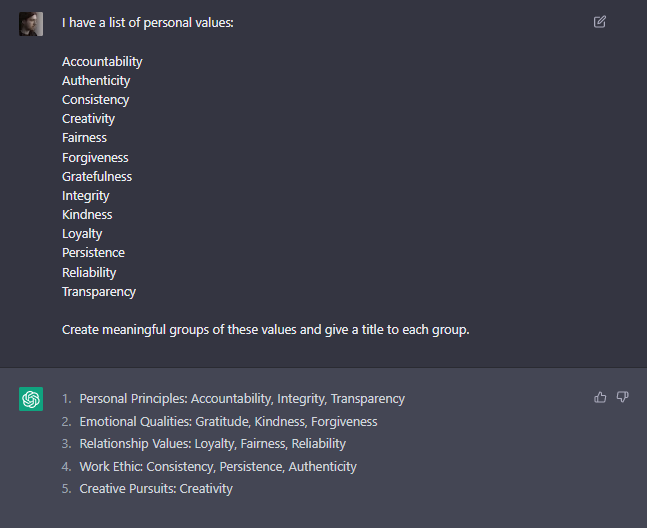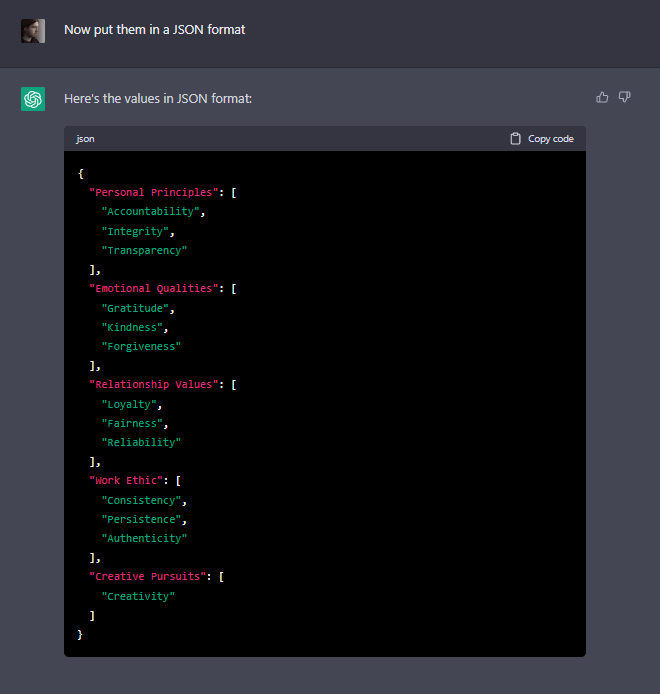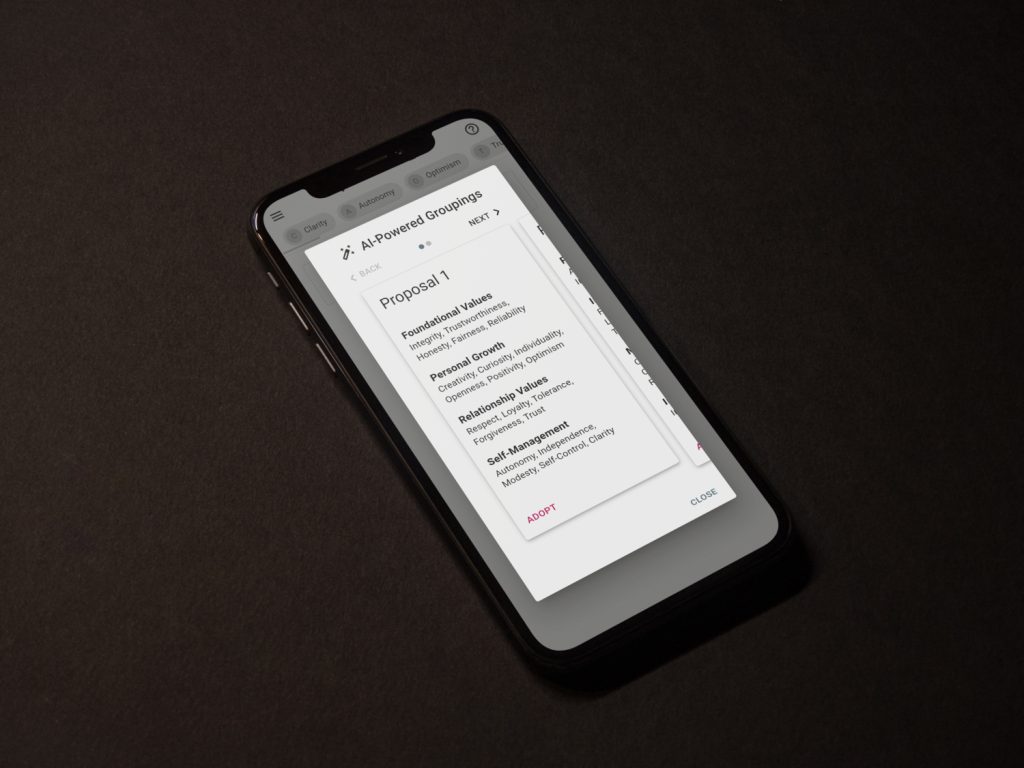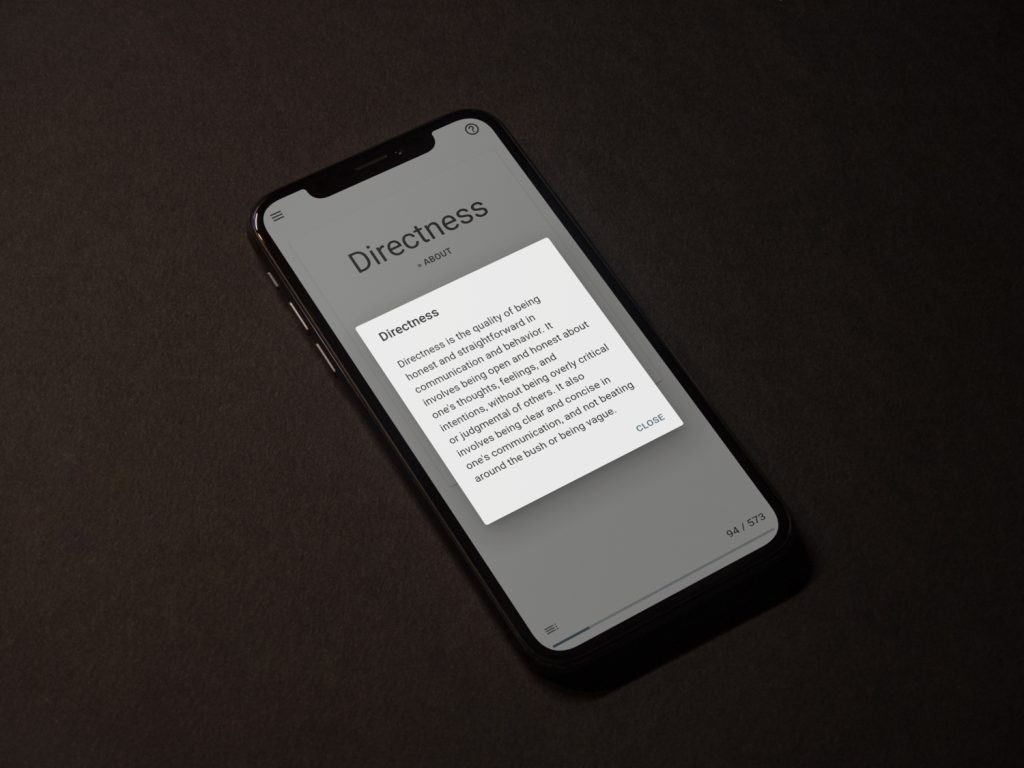The world can’t stop talking about ChatGPT. It is mighty impressive, but can it only be used for research or writing articles? I used GPT-3 to implement features in my app Values Finder that were previously beyond reach. So now I can say from personal experience: it opens up completely new possibilities.
Example 1: Creating meaningful groups from a list of personal values
Values Finder is a small app to discover your personal values. The principle is simple: First, you browse a comprehensive database of possible values playfully. If a value appeals to you, swipe right, otherwise swipe left – you can try to guess the working title of the project in the comments. 😉 In the end, you have a fairly extensive list of values that is somewhat unwieldy in its raw form. Therefore, you can cluster them into meaningful groups with drag and drop.

The first step, the browsing/swiping, is very easy and does not require much mental energy. The second step, however, requires some thinking. In user tests, I have repeatedly found that grouping is the bigger challenge and users would love to have some support. Unfortunately, this is a tough problem to solve. There are too many possible personal values to add some reasonable editorial support. So, the problem has been waiting for a solution…
… until ChatGPT took the stage. While I was playing around with it, I simply asked ChatGPT to group a list of values for me:

Wow. First attempt and an answer that I couldn’t have given better.
And how do I process that programmatically? Let’s just ask ChatGPT:

I am speechless.
After a few more tests, it turns out that these were not random hits. ChatGPT reliably creates useful groups almost every time. The solution to my users’ problem has been found: ChatGPT can help them group their values.
Technically, there was still a little work to be done, but it was almost trivial: ChatGPT has no API, so I have to use the underlying technology GPT-3 (Model: text-davinci-003). There is a paid API for this. I now call up 5 suggestions at once via this API, from which my users can choose. Then I filter out the suggestions that didn’t work as well. Sometimes the AI just puts all the values into one giant group. Or adds the same value to many groups. With a few simple rules, I discard such and a few other glitches. In general, there is always enough that is usable.
So here’s a screenshot of the final feature:

Example 2: Explaining Personal Values
Another point that stands out in user tests is that some values are hard to understand. Common values such as freedom are known to everyone. However, the database is very extensive and includes less common values as well. What does “fortitude” mean as a personal value? I hadn’t been able to solve this problem so far. The database includes over 500 personal values in English and nearly 400 in German. I can’t write definitions for almost 900 values.
…but ChatGPT can. 😉

So, I relied on GPT-3/text-davinci-003 again, wrote a small script, and automatically retrieved all value descriptions. And now, Values Finder has an explanation for each value:

This example is a bit less exciting because I used GPT-3 for it’s main use case of content generation. But it shows very nicely that text generation is not only usable for writing articles.
Recap
I am deeply impressed. Although there are plenty examples where ChatGPT makes a fool of itself, it already enables things that were previously unthinkable. It’s a completely new way of working. And it’s usable by anyone! So far, AI could only be used for very specific cases (speech recognition, categorization, etc.). If you had a new application that the model wasn’t explicitly intended for, you needed vast amounts of data and/or many resources to train a new model. But ChatGPT/GPT-3 is so generic that you can build anything with it, even if it wasn’t explicitly intended for it. Even an independent developer like myself can create completely new applications with little effort. I am incredibly excited to see what further new applications the developer community will conjure up.
By the way, this article was not written by ChatGPT. 😉 But ChatGPT helped with the translation (it was originally written in a German magazine). And DALL·E created the header image. 🙂
About Values Finder
Values Finder is available for free on the Apple App Store and Google Play. It can also be used and customized as a coaching tool for personal values.
